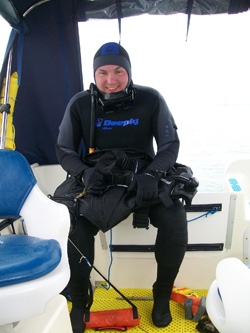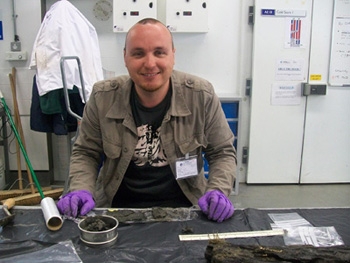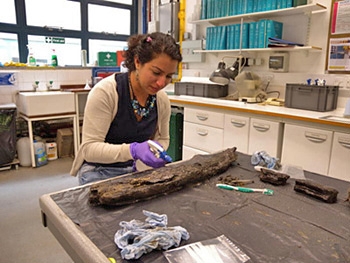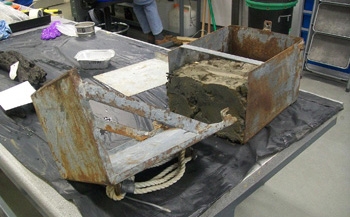Training Reports 2010 - Hampshire and Wight Trust for Maritime Archaeology, Southampton, UK

Two Early Stage Researchers took part in STSMs with HWTMA in June, gaining experience on the unique underwater Mesolithic site of Bouldnor Cliff, including working on the organisational logistics of the operation, diving on site, and laboratory anaysis of sediments and wood recovered from excavation.
Leandro Infantini (PhD student, University of Algarve, Portugal)

My STSM was carried out with the Hampshire & Wight Trust for Maritime Archaeology (HWTMA) for a two-week period from 3–17 of July (2010). This was a great opportunity to see and learn about the investigations of submerged prehistoric landscapes in an active context.
On the one hand, we could see and participate in the logistics and diving operations on the Bouldnor Cliff archaeological site, near the Isle of Wight. On the other hand, we did post-fieldwork tasks such as excavation of recovered blocks of seabed material and processed samples using facilities at the National Oceanographic Centre. It was an important opportunity to study and handle unique preserved Mesolithic materials such as worked timber and hazelnuts.
In the first week, the activities were focused mainly on the study of the archaeological site and in the logistic preparation for the diving, such as inspection of SCUBA tanks. In this period I examined samples from previous excavations, such as wood, stored in the cold store in NOC and read papers about the site, and took part in diving operations on the Bouldnor Cliff site, working out of Lymington Port to reach the site.

Several dives were carried out on Bouldnor Cliff II (BC-II) and Bouldnor Cliff V (BCV) during which we placed markers for locating the sites, collected lithic artefacts and other samples, and conducted systematic recording of all information.
For the latter part of my stay, we carried out post-excavation study in the NOC. We collated and analysed photographs and drawings of the samples collected at the site and also material from previous years. We also carried out excavation in the laboratory and recording of samples taken from the site.
As a result, we recorded a lot of new archaeological information. In this STSM, I gained experience in the preparation logistics and complexity of diving operations, and in post-excavational work and laboratory analysis studying the uniquely preserved organic material from this important underwater Mesolithic site.
Sorna Khakzad (PhD Student, University of Leuven, Belgium)

I attended one of the first SPLASHCOS STSMs which was organized by Hampshire and Wight Trust for Maritime Archaeology in Southampton, England, for two weeks in June 2010. The host project was an ongoing ten-year research project, started after a burrowing lobster revealed worked flints from a submerged landsurface off Bouldnor Cliff in the North of the Isle of Wight. I was cooperating in on-land activities, which focused on: managing the data; planning the activities; excavating, sorting out and documentation of the samples; and analyzing the results and setting the entire data into an overall picture.
There was a systematic procedure followed by the underwater archaeologists and on-land team. For the excavation and sampling a system of grids was established. The archaeologists brought samples out from different areas. These sample boxes (20x30x15 cm) represent a small section of the deposits, through which different layers of occupation and settlement can be studied.
We were excavating the sample boxes containing soils and sand from the submerged site; different layers were to be distinguished, measured, sketched, photographed and documented. From the sample boxes we collected and documented remains of wood, shells, herbs, seeds and so forth. The location of all finds was marked as well as registered on the grid-map. Through tracking the artefacts, and linking the information, the aim was to understand the site and its formation.

The finds were studied to identify their purpose; timber for housing or boats, stone objects as blade, arrow, or other. These objects provide information to recognize the site function as a settlement, a boat-building site, or other purpose, intending to reconstruct different layers of the ancient landscape.
The work also included evening discussions and evaluation of the program. In these sessions experts could develop new ideas from the excavation methodology to manage the site in a very friendly environment with other colleagues and heads of the project. As outside researchers we need to look at a system and also develop ideas which might be helpful or more efficient. This STSM offered me the opportunity to examine some of my theories and to evaluate them through practice. For my PhD research it was a very good opportunity to achieve an understanding of the management issues, and practical and theoretical aspects involved in an underwater archaeological project.








